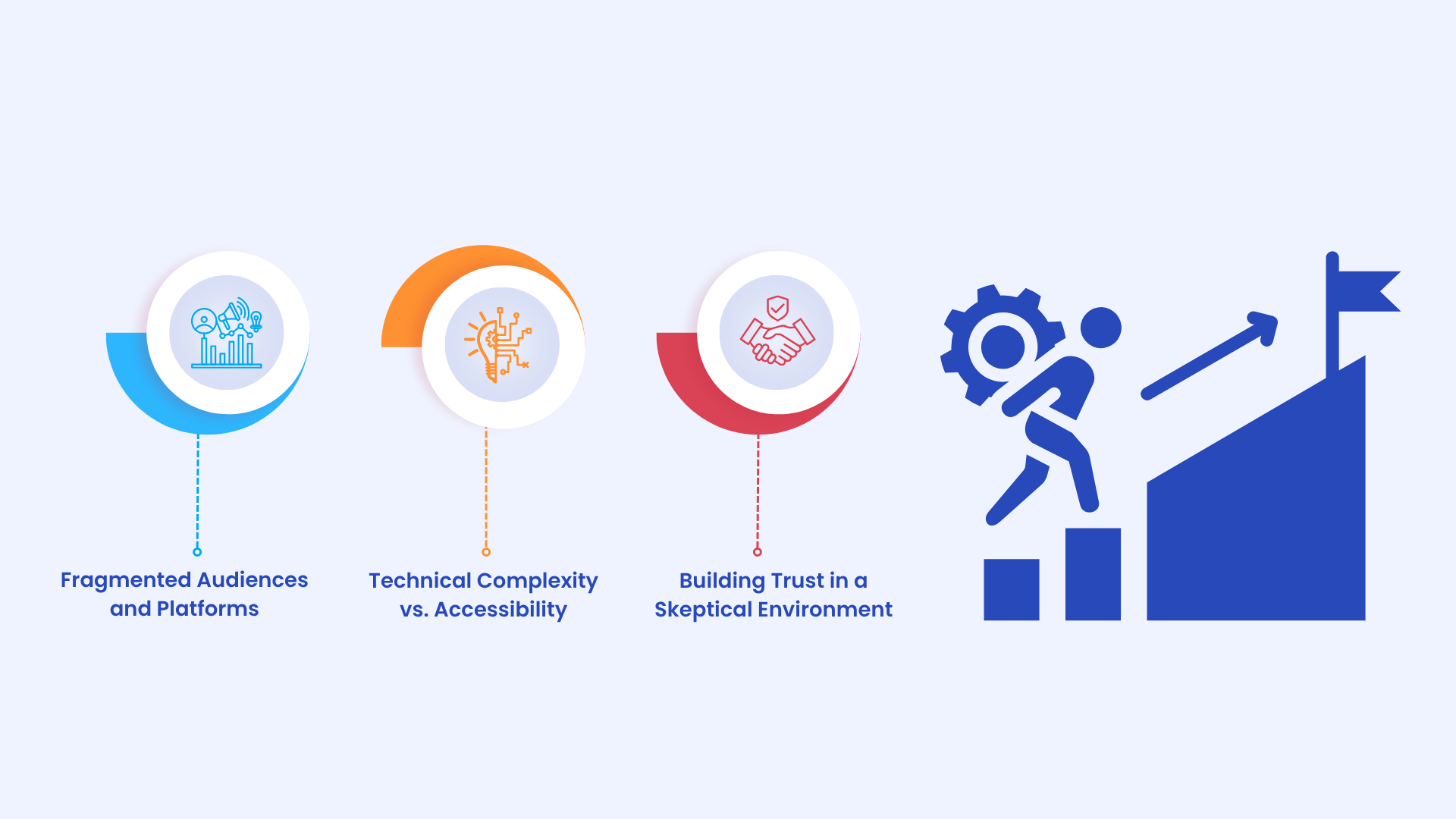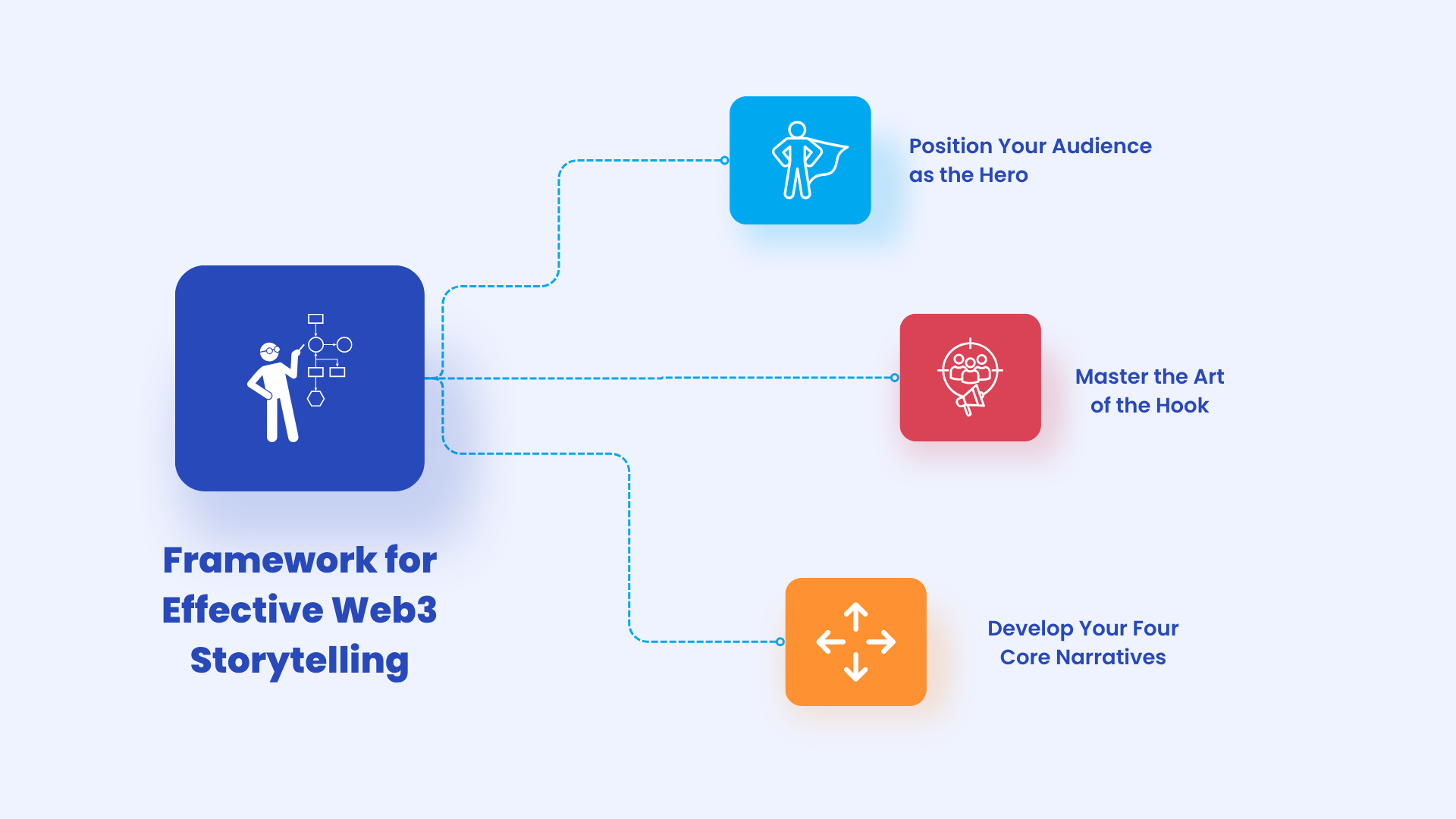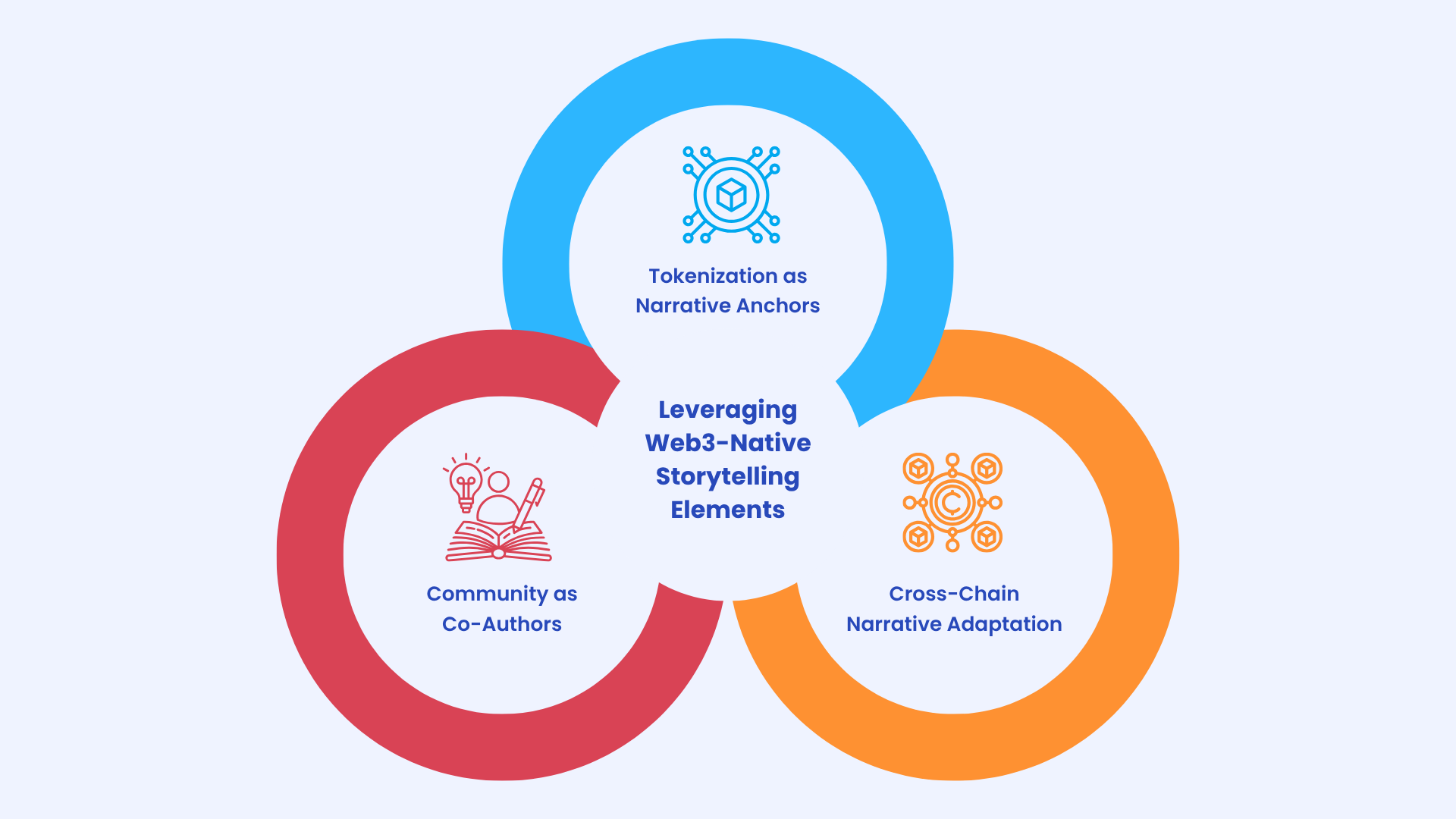Web3 storytelling requires a fundamentally different approach from traditional marketing.
In a space where audiences are fragmented, concepts are technical, and skepticism runs high, brands must focus on clarity over complexity.
Successful storytelling in web3 positions your audience as the hero of the narrative, uses strategic hooks to capture attention, and builds trust through consistent messaging across platforms.
The key is to make complex blockchain concepts relatable without oversimplifying them, while leveraging unique web3 elements, like tokenization and community participation, as narrative anchors.
TL;DR
- Web3 storytelling demands clarity, authenticity, and audience-centric narratives, distinct from traditional marketing.
- Effective strategies involve positioning the audience as the hero, using engaging hooks, and developing core narratives.
- Leverage Web3 native elements like tokenization and community co-authorship to build trust and consistent messaging.
Why Web3 Storytelling Matters More Than Ever
Web3 storytelling has become the differentiating factor between projects that capture lasting attention and those that fade into the background noise of an oversaturated market.
In web3, people aren’t just consumers of your brand story. They’re potential stakeholders, community members, and co-creators of your narrative.
This shift from passive consumption to active participation means your storytelling approach must be more authentic, transparent, and engaging than ever before.
Now, here’s the challenge.
Most crypto projects are built by brilliant technical minds who understand consensus mechanisms, tokenomics, and blockchain architecture inside and out. However, translating that technical expertise into compelling narratives that resonate with diverse audiences requires a different skill set entirely.
“The biggest mistake I see crypto brands make is leading with the technology instead of the transformation. People don’t invest in protocols. They invest in possibilities. Your story should focus on the change you’re creating, not just the code you’re writing,” says Alex Lielacher, founder of Rise Up Media.
The Unique Challenges of Web3 Storytelling

Now, let’s look at what makes storytelling in Web3 a little bit more challenging than in other industries.
Fragmented Audiences and Platforms
Your audience might discover your project through a Twitter thread. Dive deeper into a Discord server. Participate in governance on a forum. Then make investment decisions based on documentation scattered across GitHub repositories.
Traditional marketing funnels don’t apply when your audience is simultaneously engaging with your brand across multiple platforms, each with its own cultural norms and communication styles.
A message that resonates on Crypto Twitter might fall flat in a Telegram group focused on DeFi yield farming.
The decentralized nature of Web3 teams compounds this challenge. Unlike traditional companies with centralized marketing departments, crypto projects often have contributors spread across time zones, cultures, and communication preferences.
Maintaining a consistent narrative, therefore, becomes exponentially more difficult.
Technical Complexity vs. Accessibility
One of the most significant hurdles in Web3 storytelling is making complex technical concepts accessible without oversimplifying them.
Your audience likely includes everyone from seasoned DeFi veterans who understand impermanent loss calculations to newcomers who are still figuring out how to set up a wallet.
This diversity requires a nuanced approach to storytelling.
You need to respect the intelligence of your technical audience while ensuring newcomers don’t feel excluded or overwhelmed.
The solution isn’t dumbing down your message, but layering your narrative so that different audience segments can engage at their comfort level.
Building Trust in a Skeptical Environment
There have been countless Web3 projects that promised revolutionary change but delivered nothing but exit scams or poorly executed ideas. This history has created a default skepticism that every new project must overcome.
Traditional trust signals, like celebrity endorsements or flashy marketing campaigns, often backfire in crypto.
Instead, trust is built through transparency, consistent delivery on promises, and authentic community engagement.
Your storytelling must acknowledge this skepticism head-on and provide tangible proof of your project’s legitimacy, whether that’s regular updates, transparent governance, or open-source code.
What Is the Framework for Effective Web3 Storytelling?

Position Your Audience as the Hero
The most effective web3 storytelling follows a fundamental principle borrowed from classical narrative structure: your audience is the hero of the story, not your project.
Your technology, team, and token serve as the guide that helps your audience overcome obstacles and achieve transformation.
This positioning shift is crucial because crypto users are inherently empowered. They control their own keys, make their own investment decisions, and actively participate in the governance of the protocols they support.
Craft narratives that acknowledge your audience’s agency and intelligence. Show them how your project enables their success, whether that’s achieving financial freedom, participating in a more equitable economy, or accessing previously unavailable opportunities.
Master the Art of the Hook
Your ability to capture interest within seconds determines whether your story gets heard at all.
Effective hooks in web3 storytelling often leverage one of several proven structures:
- Contradiction hooks work particularly well in crypto because the space is full of counterintuitive insights. For example: “The best way to increase decentralization? Start with centralization.” This type of hook immediately creates cognitive tension that compels people to learn more.
- Question hooks tap into the community’s natural curiosity and desire to stay informed. “What if the next bull run isn’t driven by speculation?” immediately positions your audience to consider new possibilities.
- Surprising statistics can be incredibly effective, especially when they challenge common assumptions. “95% of DeFi users have never participated in governance,” reveals a gap between ideology and reality that demands explanation.
Develop Your Four Core Narratives
Every successful crypto project needs to articulate four foundational stories that work together to create a comprehensive brand narrative.
- Your Story of Now provides clear, actionable ways for your audience to get involved immediately. This might include joining your community, testing your protocol, participating in governance, or contributing to development. The key is making participation feel meaningful and accessible.
- Your Origin Story explains how your project came to exist and why it matters now. This isn’t just a timeline of technical development, but a compelling narrative about the problem you discovered and why existing solutions weren’t sufficient.
- Your Personal Story humanizes your project by explaining why you specifically are the right person or team to solve this problem. Web3 founders are often anonymous, and personal stories become even more valuable for projects that choose transparency.
- Your Group Story positions your project within the broader context of the crypto ecosystem and societal change. Articulate your vision for how your project contributes to the larger transformation that blockchain technology enables.
What Are Some Web3 Storytelling Elements?
For your brand to effectively tell its Web3 story, you must leverage some storytelling elements that are native to the space. Let’s take a look at three of these:

Tokenization as Narrative Anchors
One of the unique advantages of storytelling in Web3 is the ability to use tokens, NFTs, and other digital assets as integral parts of your narrative structure.
These aren’t just fundraising mechanisms or speculative assets. They’re story elements that create tangible connections between your audience and your project’s evolution.
Successful projects use tokenization to make their community feel like stakeholders in the story’s outcome. You could opt for NFT drops that evolve based on project milestones, governance tokens that unlock exclusive content, or reward mechanisms that recognize community contributions to the narrative itself.
The key is ensuring that your tokenomics align with your storytelling goals.
If your narrative emphasizes community ownership and decentralized governance, but your token distribution is heavily concentrated among early investors, the disconnect will undermine your credibility.
Community as Co-Authors
Unlike traditional brands where the company controls the narrative, Web3 projects must embrace the reality that their communities will actively shape and extend their stories.
Successful projects create frameworks that guide community storytelling while allowing for creativity and personal expression. This might include providing narrative templates, creating contests for user-generated content, or establishing governance mechanisms that let the community vote on major narrative directions.
The goal isn’t to control every aspect of how your story is told, but to provide enough structure and inspiration that community-generated content reinforces your core narrative.
Cross-Chain Narrative Adaptation
As the crypto ecosystem becomes increasingly multi-chain, your storytelling must adapt to different blockchain cultures while maintaining core consistency.
Each blockchain ecosystem has its own communication norms, values, and expectations.
Ethereum communities tend to value technical depth and long-term thinking. Solana users often prefer faster-paced, casual communication. Bitcoin maximalists respond to narratives about sound money and decentralization.
Your core story remains the same, but the way you tell it should reflect each chain’s culture.
Need an Effective Story For Your Web3 Brand?
Web3 storytelling is about creating a narrative framework that can sustain and inspire a community through the inevitable ups and downs of the crypto market.
The projects that succeed long-term are those that build stories robust enough to weather bear markets, flexible enough to adapt, and authentic enough to maintain credibility as they scale. But without a compelling story to help people understand why it matters, even the most innovative projects can fade into obscurity.




